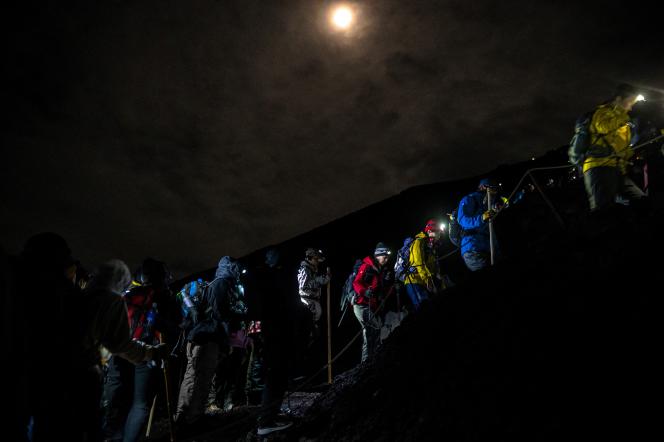LETTER FROM TOKYO
Summer and its strong heat settle in Japan. For many, the season coincides with the long-awaited opening of the Mount Fuji climbs. In a Japan that is returning to mass tourism after the Covid-19 pandemic, the highest peak in the Archipelago, culminating at 3,776 meters in the heart of the Kanto plain, is preparing to welcome a record number of climbers. , all eager to reach the summit of this volcano with its almost perfect conical shape, but with the tricky slopes treated a little too lightly.
“Underestimating the risks of climbing can cause accidents, health problems and even fatal tragedies”, recalled, on May 22, Yoshiro Sanada, executive director of the Fuji-Yoshida tourism promotion service, on the sidelines of a religious ceremony organized for the well-being of climbers, at the entrance to the Yoshida route, one of the four leading to the top. This route from Yamanashi Prefecture will be inaugurated on 1er July. Fujinomiya, Subashiri and Gotemba lanes on the slope of Shizuoka Prefecture will open on July 10. They will remain accessible until September.
The fear of the authorities mainly concerns the “wild” climbs made in one go, by tourists coming at night by car and chaining by a walk to reach the summit in the early morning. It is normally recommended to arrive the day before and to sleep in one of the refuges installed at the eight stations leading to the summit. The awakening is then done in the early morning and the climb begins to reach the ninth station, at the top.
Object of worship
However, this use is complicated this year by the lack of places. On the Yoshida route, which attracts 60% of climbers, the refuges are almost full. The Goraikoukan, located at 3,450 meters above sea level, opened its reservation site on May 8. The influx of requests blocked him. It was revived the next day. Within an hour, all available rooms were booked for the entire season. “We never saw that before the season opener”, explain the persons in charge of the site. Some refuges on the Fujinomiya route have recorded twice as many reservations as usual.
The saturation of refuges stems from the enthusiasm for the still active volcano – the last eruption dates back to 1707 – which remains an icon of Japan, and an object of veneration for more than a millennium, both for Shintoism (first religion of Japan) than for Buddhism. The first to have climbed it would be a Buddhist monk, En-no-Shokaku, in the year 700. Hermits climbed there to acquire miraculous faculties. Mount Fuji appears in some poems in the anthology Manyoshu, “the collection of 10,000 sheets” composed in 760 by Otomo no Yakamochi. The great masters of print have represented him: Hokusai with his Thirty-Six Views of Mount Fuji or Hiroshige and his Fifty-Three Tokaido Relays. It is now a popular tourist destination. Its inclusion in 2013 as a UNESCO World Heritage Site has only reinforced its appeal.
You have 46.25% of this article left to read. The following is for subscribers only.
